
views
X
Trustworthy Source
Mayo Clinic
Educational website from one of the world's leading hospitals
Go to source
Alleviating Pain Medically

Ask your doctor about anticonvulsant medicines. Anticonvulsant medications are one of the most common treatments for trigeminal neuralgia. Your doctor may prescribe one or more anticonvulsants until he finds the one that works the best to manage your pain symptoms. Anticonvulsant medications are typically prescribed instead of traditional painkillers (such as non-steroidal anti-inflammatory drugs), which are not as effective at blocking the electrical signals from the misfiring neurons that are causing the sensations of pain. Carbamazepine is the usual initial anticonvulsant medication treatment since it’s been studied the most. You may experience drowsiness, dizziness, nausea, and vomiting as side effects, but they may not be as prominent if you start with a lower dose and titrate up slowly. Oxcarbazepine is similar to carbamazepine in effectiveness and may be better tolerated, but is more expensive. Gabapentin and lamotrigine are often used for patients who cannot tolerate carbamazepine. Baclofen may be a useful medication to take alongside the anticonvulsant, particularly in patients with TN related to multiple sclerosis. Anticonvulsant medications may lose their efficacy over time as they build up in the bloodstream; at this point, your doctor may switch your prescription to a different anticonvulsant that your body has not grown insensitive to or use adjunct therapy with another medication such as lamotrigine.
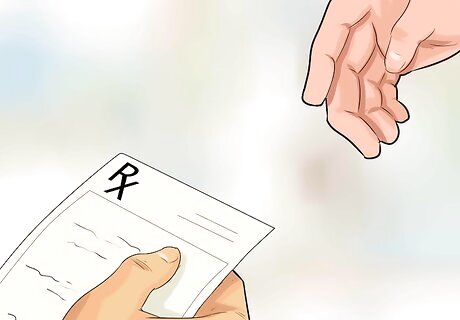
Get a prescription for tricyclic antidepressants. Tricyclic antidepressants are commonly used to manage symptoms of depression but they can also be prescribed to manage chronic pain. Tricyclic antidepressants are often effective in managing chronic pain conditions, such as atypical facial pain, but are not generally useful in classical trigeminal neuralgia. Tricyclic antidepressants tend to be prescribed in lower doses for chronic pain management versus when they are used to treat depression. Common tricyclic antidepressants used to treat chronic pain include amitriptyline and nortriptyline.
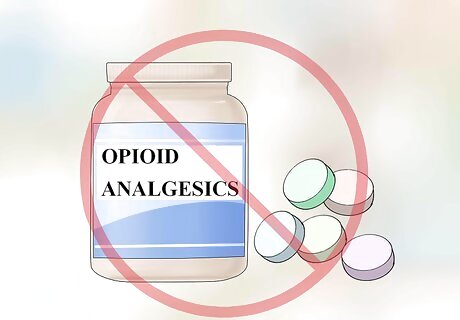
Avoid analgesics and opioids. Analgesics and opioids are not useful in managing the paroxysms of pain in classical TN. However, some people with TN2 respond to analgesics and opioids. TN2 consists of constant pain that can be dampened by these medications as they build up in the bloodstream, while TN1 consists of sharp recurring pain episodes that cannot effectively be lessened by these drugs. Your doctor can prescribe analgesics and opioids such as allodynia, levorphanol, or methadone.
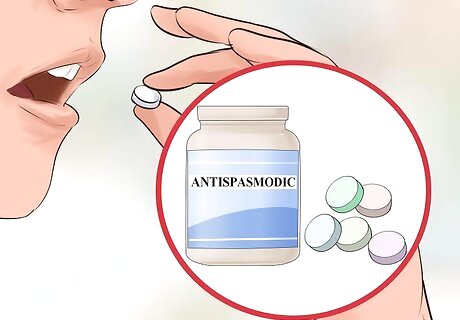
Try antispasmodic agents. Antispasmodic agents are used to ease pain sensations caused by trigeminal neuralgia attacks. They are sometimes used in conjunction with anticonvulsants. Antispasmodics, otherwise known as muscle relaxants, are prescribed to treat trigeminal neuralgia because they inhibit involuntary muscle movements that can be triggered by misfiring neurons during a trigeminal neuralgia episode. Common antispasmodics include Kemstro, Gablofen, and Lioresal; these are all members of the baclofen family of drugs.

Ask about Botox injections. Your doctor may consider Botox injections to treat your trigeminal neuralgia if you become insensitive and unresponsive to anticonvulsants, tricyclic antidepressants, and antispasmodic medications. Botox may be effective for pain management in patients with trigeminal neuralgia, especially those with rapid muscle twitching, but there have not been many studies to know the results. Many people feel uncomfortable considering Botox injections due to negative connotations from their use in plastic surgery; however, you should not discount this treatment modality because it can effectively help you to manage your chronic facial pain after you have exhausted your other options. Botox injections may be beneficial for patients that have medically refractory trigeminal neuralgia, though there isn’t a lot of data.
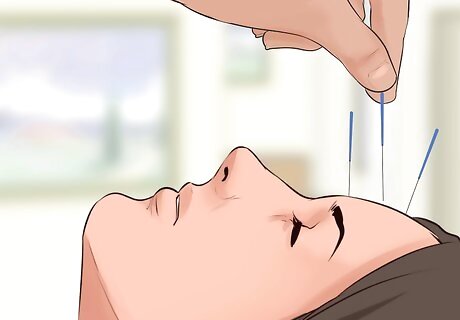
Consider alternative medicine. Alternative medicine options have not been studied enough to be determined as effective for treating trigeminal neuralgia. Even so, many people report some pain relief from modalities such as acupuncture and nutritional therapy.
Alleviating Pain Surgically
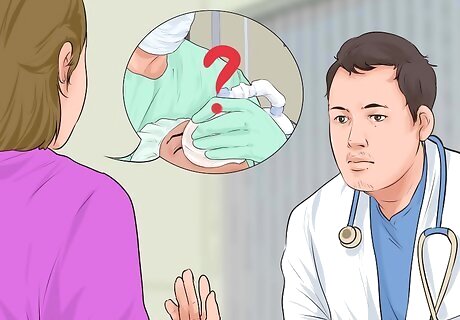
Ask about surgery. Trigeminal neuralgia is a progressive condition. Although medications can help you manage symptoms over time, more aggressive cases of this condition can lead to permanent damage to the trigeminal nerve, which can result in debilitating pain or partial permanent facial numbness. If you do not respond to medication surgery may be considered. Your doctor will work with you to help you choose the best surgery based on your health and medical background. The degree of severity of your trigeminal neuralgia, prior history of neuropathy, and general health all factor into the options that are available to you. The overall goal of surgery is to minimize damage to the trigeminal nerve as trigeminal neuralgia advances and to improve quality of life when medications no longer effectively manage pain.
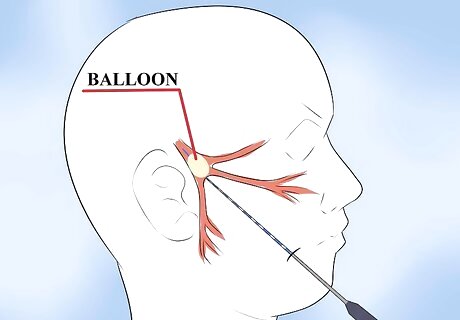
Try balloon compression. The goal of balloon compression is to slightly damage the trigeminal nerve branches so that pain impulses cannot be transmitted. During the procedure, a small balloon is inserted into the skull through a catheter and as it inflates, the trigeminal nerve is pressed against the skull. This is typically an outpatient procedure that is performed under general anesthesia, although sometimes an overnight hospital stay is needed. Balloon compression results in about two years of pain relief. Many patients experience temporary facial numbness or weakness in muscles used for chewing after undergoing this procedure, but are generally relieved of pain symptoms.
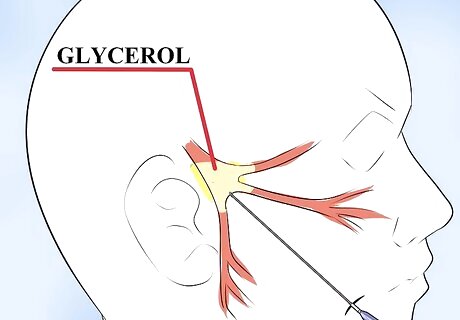
Ask about glycerol injection. Glycerol injection is used to treat trigeminal neuralgia that particularly affects the third and lowest branch of the trigeminal nerve. During this outpatient procedure, a thin needle is inserted through the cheek into the base of the skull and near the 3rd division of the trigeminal nerve. Once the glycerol is injected, it damages the trigeminal nerve, resulting in pain relief. This procedure usually results in about 1 to 2 years of pain relief.
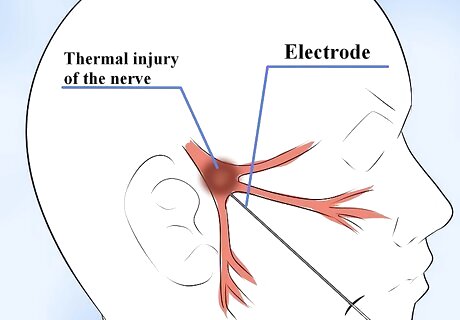
Try radiofrequency thermal lesioning. Radiofrequency thermal lesioning, also known as RF ablation, is an outpatient procedure consisting of coagulating nerve fibers with an electrode to desensitize areas where you experience pain. During the procedure, a needle with an electrode is inserted into the trigeminal nerve. Once the area of nerve that causes the pain is located, your doctor sends small electrical pulses through the electrode to damage the nerve fibers, resulting in numbing of the site. In about 50% of the patients, the symptoms reoccur three to four years following the procedure.
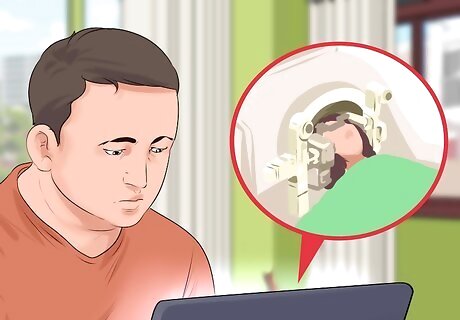
Research stereotactic radiosurgery (or gamma knife). This procedure uses computer imaging to send focused radiation to the trigeminal nerve. During the procedure, the radiation creates a lesion of the trigeminal nerve, which disrupts sensory signals to the brain and reduces pain. Patients can often leave the hospital the same day or the day following the procedure. Most patients who undergo gamma knife report pain relief after a few weeks or months but pain often reoccurs within three years.
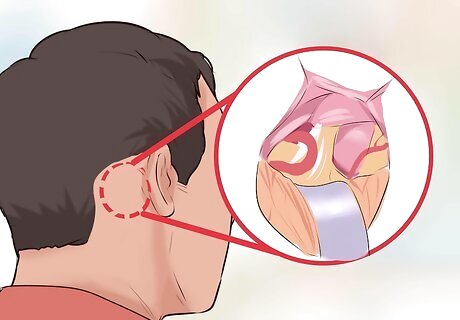
Try microvascular decompression (MVD). MVD is the most invasive surgical procedure for trigeminal neuralgia. During surgery, your doctor makes a hole behind the ear. Then, using an endoscope to visualize the trigeminal nerve, your doctor will place a cushion between the nerve and the blood vessel that compresses the nerve. The recovery time for this procedure varies from person to person and often requires a hospital stay. This is the most effective surgical treatment for trigeminal neuralgia. About 70-80% of patients have immediate, complete pain relief and 60-70% remain pain-free at 10-20 years.
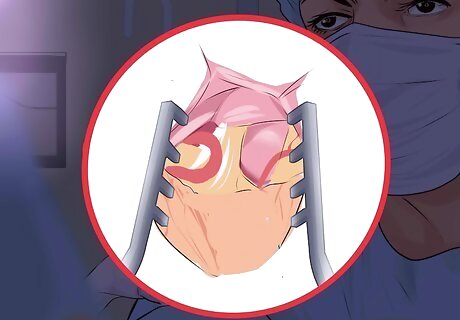
Understand neurectomy. Neurectomy involves removing a part of the trigeminal nerve. This invasive, ablative procedure is reserved for patients who are refractory to other treatments or who cannot undergo alternative surgical procedures. Neurectomies may work for treating trigeminal neuralgia, but most evidence has been negative or inconclusive. Neurectomies are often performed when a blood vessel is not found pressing on the nerve during an MVD. During the procedure, different portions of the trigeminal nerve's branches are removed to grant pain relief.















Comments
0 comment